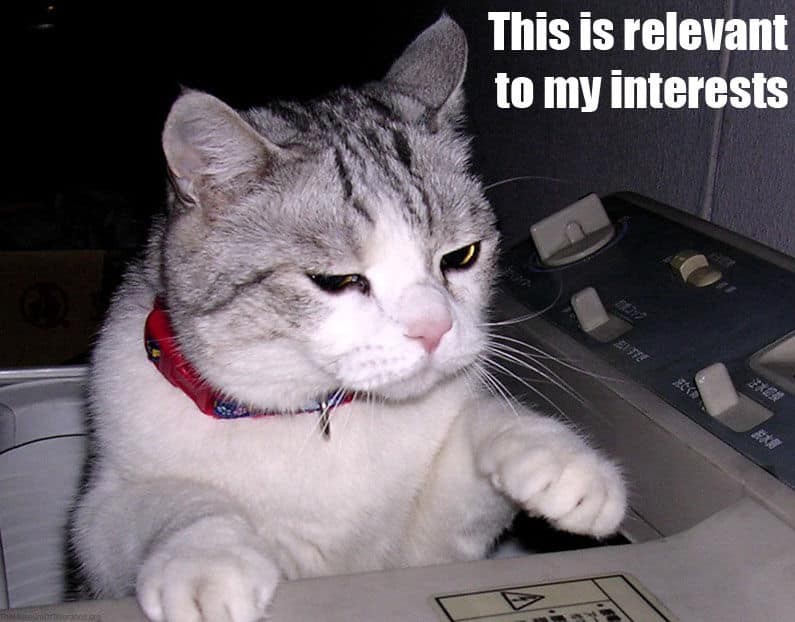How Do I Improve Ad Relevance?
by Casey Walrath • January 17, 2014
By now you’ve probably noticed that the internet has ads. Lots of ads, in fact. Maybe you’ve got a great product or service and would like to do some advertising yourself.
But in this sea of ads, ads, and more ads, how can you make yours stand out, particularly in the realm of pay-per-click marketing? One of the buzzwords you’ll hear over and over again in search engine marketing is relevance, which is the key to successful advertising.
If you’ve ever wondered “How do I improve ad relevance in my PPC campaigns?” here are 5 things you can do to get started today.
1. Put Your Keywords Front and Center
Whether you’re advertising on Google or Bing, selections of your ads that match the user’s search query will show up bolded. Bold text tends to stand out more . Therefore, you want to make sure the keywords you’re bidding on feature prominently in your ads to maximize their relevance.
Whenever possible include your search keyword in your ad headline, and again in the display URL. If you’re selling widgets at UltimateWidgets123.com and bidding on the keyword [blue widgets], your ad headline should say something like “Buy Blue Widgets” or “Blue Widgets for Sale”. You can also have your display URL read UltimateWidgets123.com/Blue-Widgets to reinforce once again that you are the go-to place for buying blue widgets.
The great thing about paid search marketing is that the user tells you what they’re looking for. Make sure your ads include your keywords to show that you provide it.
2. Use Tightly Grouped Ad Groups
If you want to improve ad relevance, this goes hand in hand with #1. As much as possible, break your keywords into as many specific ad groups as possible. If a user searches for red widgets, you don’t want them seeing your Blue Widgets ad—you want a separate ad group for red ones.
In fact, you’ll usually want to break things down even further. Create ad groups for longer keyword variations as well. You might have an ad group for “Blue Widgets”, one for “Cheap Blue Widgets”, one for “Dark Blue Widgets, and one for “Light Blue Widgets.” Each ad group can get its own specific, highly relevant ads. When breaking out long-tail keywords, let the Search Terms report guide you. If you get multiple clicks from relevant long-tail keywords, you should probably bid on them.
How many keywords should you have in each ad group? The general best practice “not very many”. Some advertisers do one keyword per ad group, some do 5-10. I like to start with three, one of each match type: exact, phrase, and broad match modified (avoid regular broad match). Therefore, my “Cheap Blue Widgets” ad group will probably bid on the keywords [cheap blue widgets], “cheap blue widgets”, and +cheap +blue +widgets.
3. Include a Clear Call To Action
A call to action is one of the most important aspects of a well-written ad, because it tells your customers what to do as they read your ad. Remember: most users will take less than a second to scan your ad, and with multiple ads competing for eyeballs on each page you need to get the user’s attention and give them a reason to click your ad immediately.
A clear call to action tells the user exactly what they’re in for. Buy Widgets Now! Get Cheap Widgets! Invest In Widgets Today! Exclamations are optional, depending on your industry, but be sure your ads are sending a clear , direct message and you’re on your way to improved relevance.
4. Don’t Neglect Your Landing Page
You might have all the right keyboards, the perfect ad group organization, and the most compelling ad copy of all time, but that’s ultimately only half of the equation. The ad click gets the user in the door, but your landing page has to close the deal.
We’ve already discussed why having tightly focused ad groups matters, so it’s no surprise that your landing page should follow the same principle. Your Blue Widgets ad should go to the page for blue widgets. If you get enough traffic, you can have dark blue and light blue widgets go to their own pages. The more your keyword, ad, and landing page match the user’s search query, the better.
We’ve written more about how to improve your landing page right here, but remember the basics: A good landing page is clear, concise, and includes keywords prominently. You also want your landing page to match the call to action in your ads when possible.
5. Test, Test, Test. Then Test Some More.
Maybe you’ve done all this but are still wondering how to improve ad relevance. The truth is that there’s no magic bullet, so always test new ideas. Test new ads against existing ones. Test the same ads going with different landing pages. Test new ad channels. If you’re not testing, you’re stagnating.
Be sure you’re not testing too many different variables at the same time: test in increments to isolate which changes lead to which results, and make sure your results are statistically significant.
Depending on your industry, 100 conversions or even 100 clicks might be enough data, but be careful about making decisions from limited data. But once you’ve got the data, pause what doesn’t work and test what does against something new!
The question “how do I improve ad relevance” doesn’t have a single answer, but if you follow these principles you’ll be well on your way to success. Good luck![/sociallocker]





